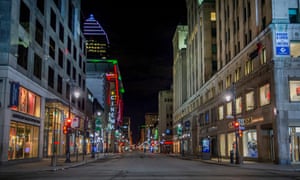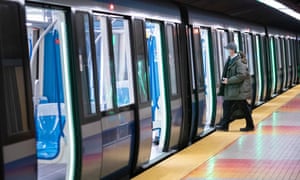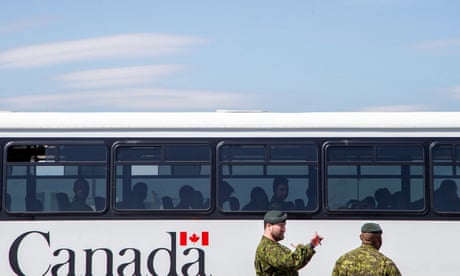The city is at the center of the crisis in Canada and Quebec is now the seventh deadliest place in the world for daily deaths
Tracey Lindeman in Montreal
THE GUARDIAN Wed 13 May 2020

Rue Ste Catherine in Montreal is usually crowded with shoppers and traffic until late at night. Photograph: Peter McCabe
Springtime in Montreal is normally a cause for celebration. After the city’s long, arduous winters, people emerge from the confines of their apartments at the first inkling of warmth to lounge in parks and on patios – or terrasses – and enjoy a meal, beverage and the company of friends.
Not this year.
Montreal, a city touted by tourist guides as “North America’s Europe” for its rich culture and joie de vivre, is Canada’s centre for Covid-19. Of the entire country’s 70,000 cases and 5,000 deaths, the city of 2 million people has 20,000 cases and more than 2,000 deaths, or about 64% of the entire province’s death toll.
Those numbers have catapulted Quebec into an unfavourable position: it is now the seventh deadliest place in the world for daily coronavirus deaths, according to Quebec newspaper La Presse.
Springtime in Montreal is normally a cause for celebration. After the city’s long, arduous winters, people emerge from the confines of their apartments at the first inkling of warmth to lounge in parks and on patios – or terrasses – and enjoy a meal, beverage and the company of friends.
Not this year.
Montreal, a city touted by tourist guides as “North America’s Europe” for its rich culture and joie de vivre, is Canada’s centre for Covid-19. Of the entire country’s 70,000 cases and 5,000 deaths, the city of 2 million people has 20,000 cases and more than 2,000 deaths, or about 64% of the entire province’s death toll.
Those numbers have catapulted Quebec into an unfavourable position: it is now the seventh deadliest place in the world for daily coronavirus deaths, according to Quebec newspaper La Presse.
“We are all concerned about Montreal,” said Quebec’s premier, François Legault, on Monday, saying that the situation there was “not under control”. The gradual reopening of schools and businesses may be further delayed if Montreal can’t get its act together.
If Peter McCabe’s Empty Montreal photo project is any evidence, the city has largely obeyed stay-home orders. His streetscapes devoid of human activity show a side of Montreal almost no one sees. “The air is crystal clear. That’s not normal,” he said.
But if people are genuinely staying home, the elevated infection rate isn’t normal either. Why are so many people getting sick and dying here?

A commuter wearing protective mask boards a subway train in Montreal. Photograph: Canadian Press/REX/Shutterstock
HOW IRONIC QUEBECOIS ARE BREAKING THE LAW BY WEARING FACE MASKS IN PUBLIC
Quebec passes law banning facial coverings in public
This article is more than 2 years old
The Canadian province is barring public workers from wearing the niqab or burqa and obliging citizens to unveil while using public transit or government services
The trends overwhelmingly point to the reality that many infected with Covid-19 are people who already experience systemic inequality, poverty and discrimination – issues that existed long before the virus, and which are now being cracked open for all to see.
First, there are the old. A horrific exposé in the Montreal Gazette revealed that a local nursing home – known by its French initials as a CHSLD – had concealed the deaths of 31 seniors. Many of them seemed to have died after most staff abandoned the facility. Some of the seniors found alive hadn’t had water, food or a diaper change in days.
Provincial data shows about 82% of the dead lived in seniors’ residences – most of them public. Of the total 2,003 dead in Montreal, 74% of them were over 80; 97% of them were over 60.
The CHSLD crisis continues. According to La Presse, at least 141 CHSLDs in Montreal presently have at least one case of Covid-19, but that the government won’t say which ones. Meanwhile, the Quebec government has announced it will allow caregivers back into some CHSLDs.

Canada's bid to beat back coronavirus exposes stark gaps between the provinces
Read more
https://www.theguardian.com/world/2020/apr/15/canada-coronavirus-covid-19-provinces-trudeau
The other part of Montreal’s Covid-19 story can be summed up by the case of Marcelin François, a 40-year-old Haitian asylum seeker who died in his wife’s arms inside their Montreal apartment in mid-April.
During the week, François worked in a textile factory. On Saturdays and Sundays, he worked as an orderly inside whichever CHSLD his temp agency dispatched him to that week.
He lived with his family in Montreal North, one of the poorest neighbourhoods in all of Canada. It is a popular destination for asylum seekers – many of whom crossed the US–Canada border on foot shortly after American president Donald Trump took office. Half of the neighbourhood’s residents are members of a visible minority, and 42% are immigrants.
Like François, many asylum seekers are now working, without citizenship status, inside of Quebec’s seniors residences. And then they’re coming home at the end of their shift, to crowded apartments they share with friends and family, inside of shoddily maintained apartment buildings.
Earlier this month, the province admitted that its effort to manage staffing shortages by moving workers around the long-term care network could be spreading the virus. Montreal North feels the consequences of that. One in five Montrealers infected with Covid-19 are healthcare workers – none of whom are receiving danger pay. In Montreal North, 23% are infected, said community organizer Will Prosper.
“It’s these people who are still taking care of us, when not too long ago they were the people who we wanted to kick out,” said Prosper.
Other areas of Montreal badly hit by Covid-19 share similar traits with Montreal North: low-income, large immigrant communities, many people of colour, poor quality housing. Montreal’s Centre for Research-Action on Race Relations is demanding the federal and provincial governments collect data on the race and income level of Covid victims.
Nargess Mustapha, also a community organizer in Montreal North and the president of youth empowerment organization Hoodstock, doesn’t need data to see how Covid-19 has further entrenched existing inequalities. She’s on the ground, along with an army of young volunteers, distributing mask-and-sanitizer kits and food hampers to members of her community.
She recites a long list of reasons why Covid-19 has struck her neighbourhood so deeply: a lack of health services, inadequate transit access, people living in crowded apartments, poor relations with police – especially now that officers can hand out $1,500 fines to those not respecting self-isolation measures.
Meanwhile, 42% of homes are single-parent households, which makes things like child care for essential workers very complicated. And, a lack of internet access makes it tough to get government aid and information being distributed almost exclusively online.
“Being able to socially distance is a sign of privilege,” Mustapha said in French, pointing out that one neighbourhood sector has almost twice the population density of New York City’s densest borough. “It’s hard to apply those rules in Montreal North
The other part of Montreal’s Covid-19 story can be summed up by the case of Marcelin François, a 40-year-old Haitian asylum seeker who died in his wife’s arms inside their Montreal apartment in mid-April.
During the week, François worked in a textile factory. On Saturdays and Sundays, he worked as an orderly inside whichever CHSLD his temp agency dispatched him to that week.
He lived with his family in Montreal North, one of the poorest neighbourhoods in all of Canada. It is a popular destination for asylum seekers – many of whom crossed the US–Canada border on foot shortly after American president Donald Trump took office. Half of the neighbourhood’s residents are members of a visible minority, and 42% are immigrants.
Like François, many asylum seekers are now working, without citizenship status, inside of Quebec’s seniors residences. And then they’re coming home at the end of their shift, to crowded apartments they share with friends and family, inside of shoddily maintained apartment buildings.
Earlier this month, the province admitted that its effort to manage staffing shortages by moving workers around the long-term care network could be spreading the virus. Montreal North feels the consequences of that. One in five Montrealers infected with Covid-19 are healthcare workers – none of whom are receiving danger pay. In Montreal North, 23% are infected, said community organizer Will Prosper.
“It’s these people who are still taking care of us, when not too long ago they were the people who we wanted to kick out,” said Prosper.
Other areas of Montreal badly hit by Covid-19 share similar traits with Montreal North: low-income, large immigrant communities, many people of colour, poor quality housing. Montreal’s Centre for Research-Action on Race Relations is demanding the federal and provincial governments collect data on the race and income level of Covid victims.
Nargess Mustapha, also a community organizer in Montreal North and the president of youth empowerment organization Hoodstock, doesn’t need data to see how Covid-19 has further entrenched existing inequalities. She’s on the ground, along with an army of young volunteers, distributing mask-and-sanitizer kits and food hampers to members of her community.
She recites a long list of reasons why Covid-19 has struck her neighbourhood so deeply: a lack of health services, inadequate transit access, people living in crowded apartments, poor relations with police – especially now that officers can hand out $1,500 fines to those not respecting self-isolation measures.
Meanwhile, 42% of homes are single-parent households, which makes things like child care for essential workers very complicated. And, a lack of internet access makes it tough to get government aid and information being distributed almost exclusively online.
“Being able to socially distance is a sign of privilege,” Mustapha said in French, pointing out that one neighbourhood sector has almost twice the population density of New York City’s densest borough. “It’s hard to apply those rules in Montreal North

No comments:
Post a Comment